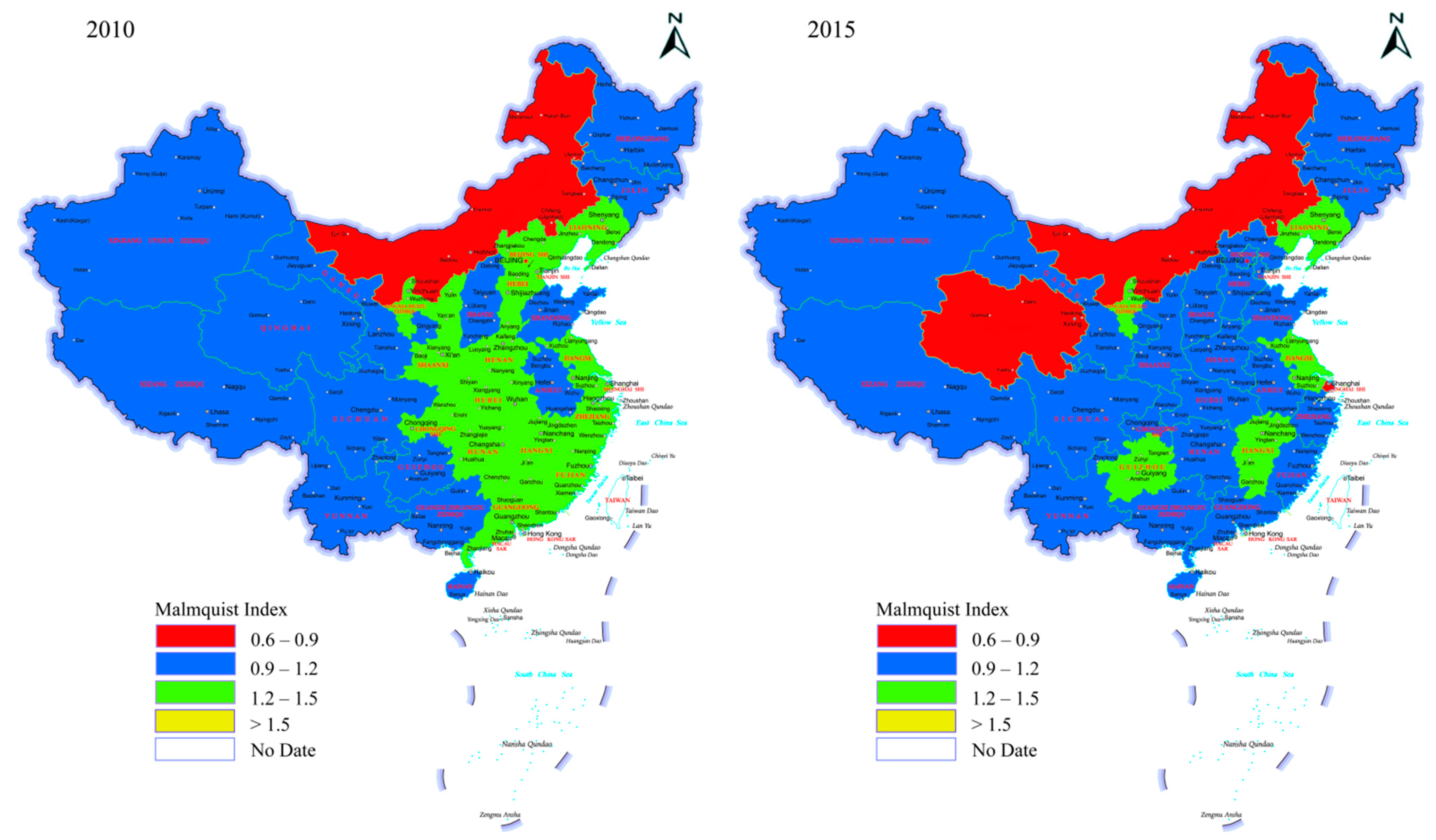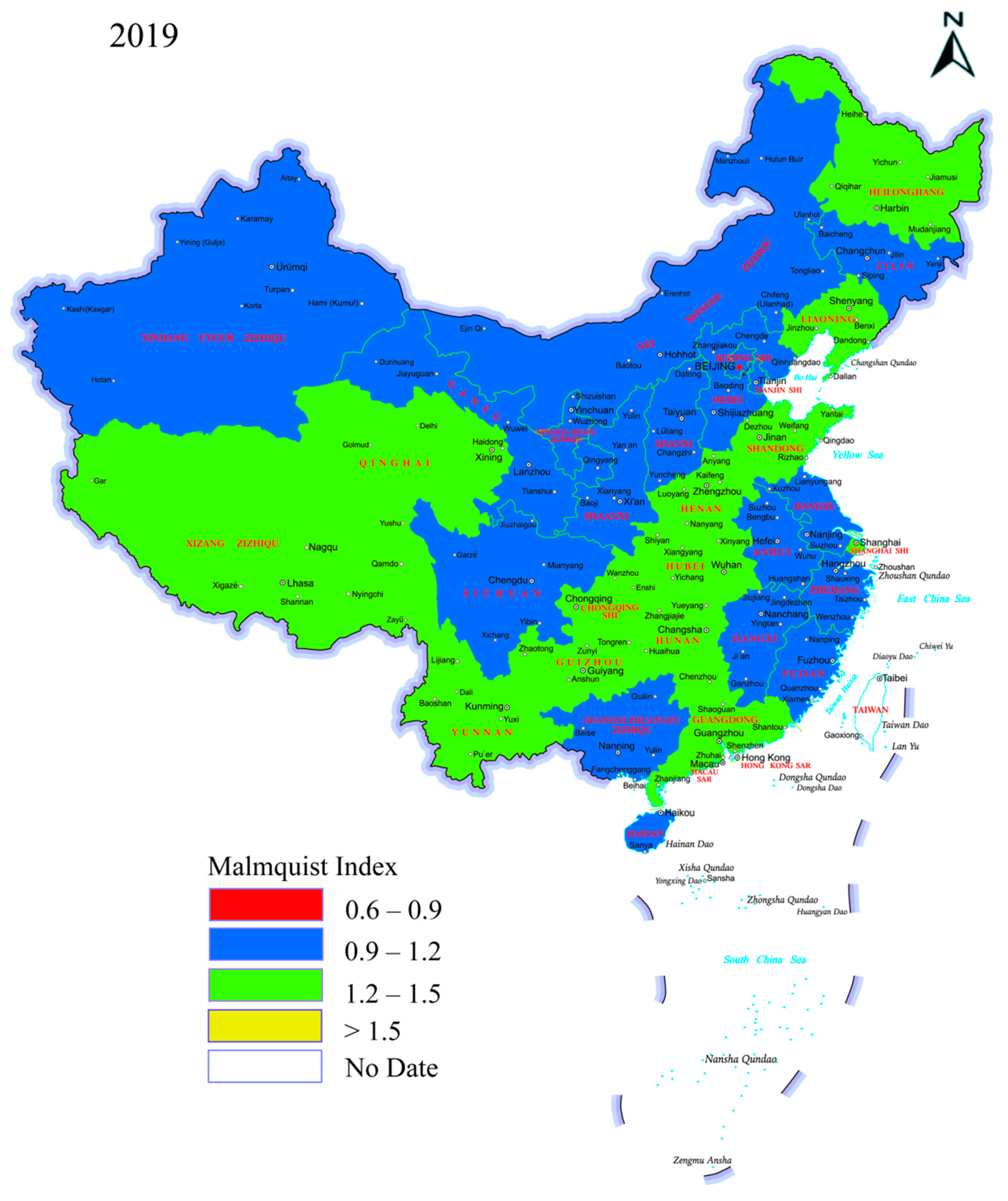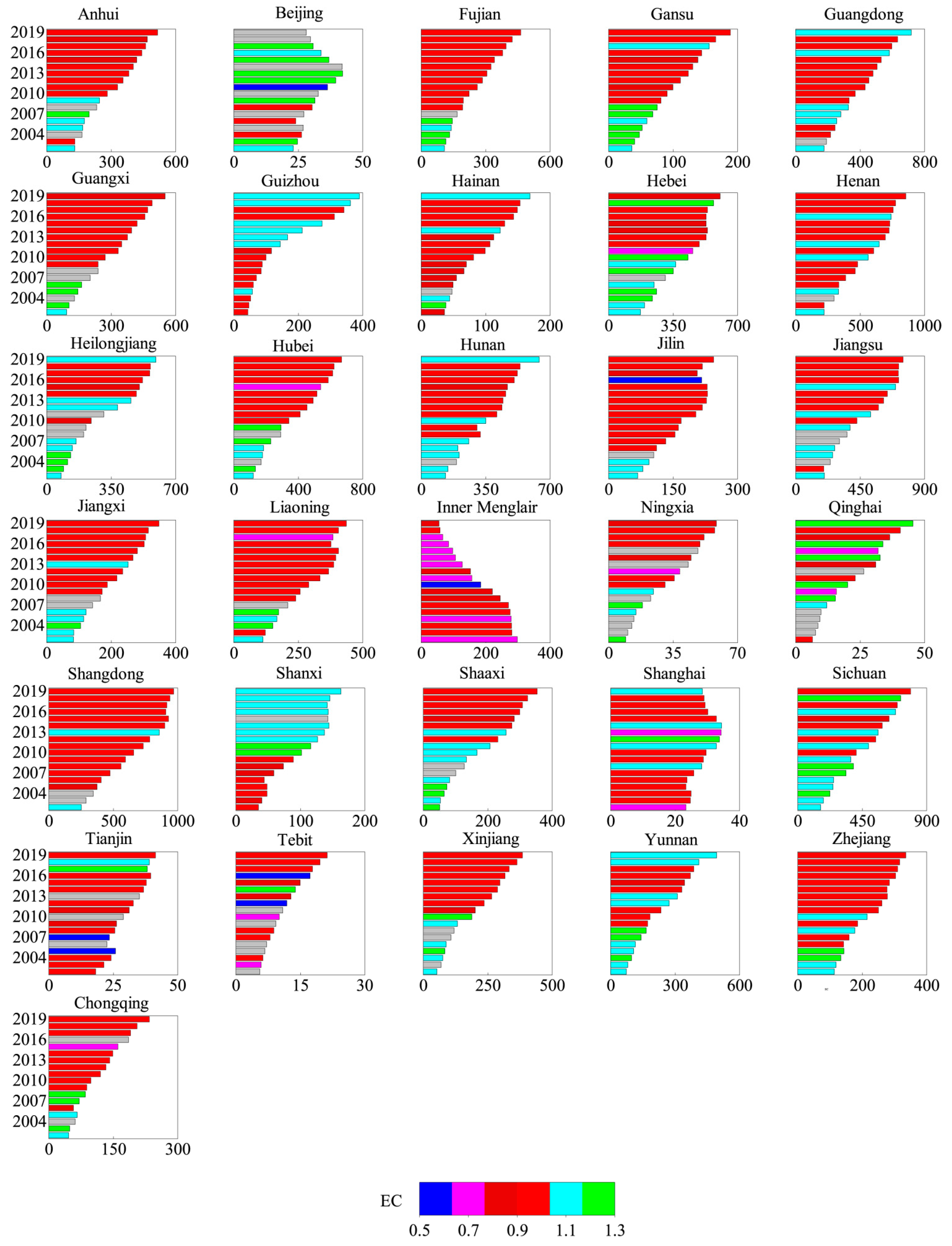Spatial Distribution and Convergence of Agricultural Green Total Factor Productivity in China
Abstract
:1. Introduction
2. Materials and Methods
2.1. Agricultural Green Total Factor Productivity
- The current benchmark:
- The global benchmark:
2.2. Convergence Test Method Based on Time Trend
- (1)
- (2)
- Conditional convergence. According to the New Theory of Economic Growth, the economic development status of distinctive districts would be specific in unique periods or in the identical period [38]. If these underlying conditions were controlled, there would be different convergence conclusions. Considering the convergence of the external environment, the conditional convergence usually tested regions [39]. If conditional convergence existed, it indicated that the AGTFP steady-state level of each region was related to the resource endowment conditions and that achieving a consistent steady-state level between regions was difficult. There were two methods to test conditional convergence: one was to fix effects by presetting individuals and time, the other was to appropriately add a control variable to the right side of the absolute convergence model. The second method held that inter-regional conditional convergence existed if the regression coefficient was still negative and statistically significant after adding the control variable, so the study used the second approach. To avoid missing important control variables, the level of economic development, agricultural industry structure adjustment, agricultural science and technology input, agricultural infrastructure, rural human capital, industrialization degree, and agricultural energy consumption were selected as control variables in line with the relevant literature [24,40]. Among them, the level of economic development was measured by the per capita gross output [41]. The restructuring of the agricultural industry was calculated by the proportion of the total output of the planting industry in the total agricultural output [42]. Agricultural science and technology input was measured by the stock of agricultural science and technology capital, which needed to be estimated based on the “perpetual inventory method” [43]. The length of highways divided by the administrative area of the province equals agricultural infrastructure [44]. Rural human capital was based on Hall and Jones by using the conversion method of education years, and the degree of industrialization was measured by the total value of non-agricultural output divided by Gross Domestic Product (GDP) [45]. Agricultural energy consumption was characterized by agricultural GDP energy consumption with 100 million yuan. The conditional β convergence test model of AGTFP was as follows.where is the growth rate of AGTFP in i province of the t period, is the control variables, is the random error term, and are the coefficients to be estimated.
2.3. Dynamic Spatial Convergence Model
2.4. Data Sources
3. Results
3.1. Spatial Analysis of Agricultural Green Total Factor Productivity
3.2. Convergence Analysis of GTFP of Agriculture
3.2.1. Absolute Convergence
3.2.2. Absolute Convergence
3.2.3. Conditional Convergence
3.2.4. Dynamic Spatial Convergence
4. Discussion
5. Conclusions
Author Contributions
Funding
Institutional Review Board Statement
Informed Consent Statement
Data Availability Statement
Conflicts of Interest
References
- Chen, Y.; Fu, W.; Wang, J. Evaluation and Influencing Factors of China’s Agricultural Productivity from the Perspective of Environmental Constraints. Sustainability 2022, 14, 2807. [Google Scholar] [CrossRef]
- Yu, D.; Liu, L.; Gao, S.; Yuan, S.; Haipeng, C.; Qianling, S. Impact of Carbon Trading on Agricultural Green Total Factor Productivity in China. J. Clean. Prod. 2022, 367, 132789. [Google Scholar] [CrossRef]
- The State of Food Security and Nutrition in the World. 2021. Available online: https://www.fao.org/state-of-food-security-nutrition/en (accessed on 11 July 2022).
- Liu, Y.; Sun, D.; Wang, H.; Wang, X.; Yu, G.; Zhao, X. An Evaluation of China’s Agricultural Green Production: 1978–2017. J. Clean Prod. 2020, 243, 118483. [Google Scholar] [CrossRef]
- Akimov, A.; Gemueva, K.A.; Semenova, N.K. The Seventh Population Census in the PRC: Results and Prospects of the Country’s Demographic Development. Her. Russ. Acad. Sci. 2021, 91, 724–735. [Google Scholar] [CrossRef] [PubMed]
- Long, D.J.; Tang, L. The Impact of Socio-Economic Institutional Change on Agricultural Carbon Dioxide Emission Reduction in China. PLoS ONE 2021, 16, e0251816. [Google Scholar] [CrossRef]
- Xu, X.; Huang, X.; Huang, J.; Gao, X.; Chen, L. Spatial-Temporal Characteristics of Agriculture Green Total Factor Productivity in China, 1998-2016: Based on More Sophisticated Calculations of Carbon Emissions. Int. J. Environ. Res. Public Health 2019, 16, 3932. [Google Scholar] [CrossRef] [PubMed] [Green Version]
- Liu, D.; Zhu, X.; Wang, Y. China’s Agricultural Green Total Factor Productivity Based on Carbon Emission: An Analysis of Evolution Trend and Influencing Factors. J. Clean Prod. 2021, 278, 123692. [Google Scholar] [CrossRef]
- Wang, Y.; Xie, L.; Zhang, Y.; Wang, C.; Yu, K. Does FDI Promote or Inhibit the High-Quality Development of Agriculture in China? An Agricultural GTFP Perspective. Sustainability 2019, 11, 4620. [Google Scholar] [CrossRef] [Green Version]
- Chen, Y.; Miao, J.; Zhu, Z. Measuring Green Total Factor Productivity of China’s Agricultural Sector: A Three-Stage SBM-DEA Model with Non-Point Source Pollution and CO2 Emissions. J. Clean. Prod. 2021, 318, 128543. [Google Scholar] [CrossRef]
- He, W.; Li, E.; Cui, Z. Evaluation and Influence Factor of Green Efficiency of China’s Agricultural Innovation from the Perspective of Technical Transformation. Chin. Geogr. Sci. 2021, 31, 313–328. [Google Scholar] [CrossRef]
- Zhang, J.; Qu, X.; Sangaiah, A.K. A Study of Green Development Mode and Total Factor Productivity of the Food Industry Based on the Industrial Internet of Things. IEEE Commun. Mag. 2018, 56, 72–78. [Google Scholar] [CrossRef]
- Zhong, S.; Li, J.; Chen, X.; Wen, H. Research on the Green Total Factor Productivity of Laying Hens in China. J. Clean. Prod. 2021, 315, 128150. [Google Scholar] [CrossRef]
- Staniszewski, J.; Kryszak, L. Do Structures Matter in the Process of Sustainable Intensification? A Case Study of Agriculture in the European Union Countries. Agriculture 2022, 12, 334. [Google Scholar] [CrossRef]
- Rahman, S.; Salim, R. Six Decades of Total Factor Productivity Change and Sources of Growth in Bangladesh Agriculture (1948–2008). J. Agric. Econ. 2013, 64, 275–294. [Google Scholar] [CrossRef] [Green Version]
- Huang, C.; Yin, K.; Guo, H.; Yang, B. Regional Differences and Convergence of Inter-Provincial Green Total Factor Productivity in China under Technological Heterogeneity. Int. J. Environ. Res. Public Health 2022, 19, 5688. [Google Scholar] [CrossRef]
- Lan, F.; Hu, R.; Mao, H.; Chen, S. How Crop Insurance Influences Agricultural Green Total Factor Productivity: Evidence from Chinese Farmers. J. Clean. Prod. 2021, 321, 128977. [Google Scholar] [CrossRef]
- Chen, H.; Zhu, S.; Sun, J.; Zhong, K.; Shen, M.; Wang, X. A Study of the Spatial Structure and Regional Interaction of Agricultural Green Total Factor Productivity in China Based on SNA and VAR Methods. Sustainability 2022, 14, 7508. [Google Scholar] [CrossRef]
- Huang, X.; Wang, X.; Chen, B.; Li, F.; Su, S.; Zhang, T. Temporal Trend and Regional Disparity of Agricultural Green Total Factor Productivity in China: Data Envelopment Analysis with Biennial Environmental Technology. Discret. Dyn. Nat. Soc. 2022, 2022, 2219779. [Google Scholar] [CrossRef]
- Yu, C.; Wenxin, L.; Khan, S.U.; Yu, C.; Jun, Z.; Yue, D.; Zhao, M. Regional Differential Decomposition and Convergence of Rural Green Development Efficiency: Evidence from China. Environ. Sci. Pollut. Res. 2020, 27, 22364–22379. [Google Scholar] [CrossRef]
- Coomes, O.T.; Barham, B.L.; MacDonald, G.K.; Ramankutty, N.; Chavas, J.-P. Leveraging Total Factor Productivity Growth for Sustainable and Resilient Farming. Nat. Sustain. 2019, 2, 22–28. [Google Scholar] [CrossRef] [Green Version]
- Yang, H.; Liu, J.G.; Folberth, C. Global Agricultural Green and Blue Water Consumptive Uses in the Context of Water Scarcity and Climate Change. In Proceedings of the 19th International Congress on Modelling and Simulation (Modsim2011), Perth, Australia, 12–16 December 2011; Chan, F., Marinova, D., Anderssen, R.S., Eds.; Modelling & Simulation Soc Australia & New Zealand Inc.: Christchurch, New Zealand, 2011; pp. 3671–3677. [Google Scholar]
- Naylor, R.L. Energy and Resource Constraints on Intensive Agricultural Production. Annu. Rev. Energy Environ. 1996, 21, 99–123. [Google Scholar] [CrossRef]
- Feng, J.; Zhao, L.; Zhang, Y.; Sun, L.; Yu, X.; Yu, Y. Can Climate Change Influence Agricultural GTFP in Arid and Semi-Arid Regions of Northwest China? J. Arid Land 2020, 12, 837–853. [Google Scholar] [CrossRef]
- Hamid, S.; Wang, K. Environmental Total Factor Productivity of Agriculture in South Asia: A Generalized Decomposition of Luenberger-Hicks-Moorsteen Productivity Indicator. J. Clean. Prod. 2022, 351, 131483. [Google Scholar] [CrossRef]
- Hu, J.; Wang, Z.; Huang, Q. Factor Allocation Structure and Green-Biased Technological Progress in Chinese Agriculture. Ekon. Istraz. 2021, 34, 2034–2058. [Google Scholar] [CrossRef]
- Chi, Y.; Xu, Y.; Wang, X.; Jin, F.; Li, J. A Win-Win Scenario for Agricultural Green Development and Farmers’ Agricultural Income: An Empirical Analysis Based on the EKC Hypothesis. Sustainability 2021, 13, 8278. [Google Scholar] [CrossRef]
- Fare, R.; Grosskopf, S.; Tyteca, D. An Activity Analysis Model of the Environmental Performance of Firms—Application to Fossil-Fuel-Fired Electric Utilities. Ecol. Econ. 1996, 18, 161–175. [Google Scholar] [CrossRef]
- Pastor, J.T.; Lovell, C.A.K. A Global Malmquist Productivity Index. Econ. Lett. 2005, 88, 266–271. [Google Scholar] [CrossRef]
- Gao, Q.; Cheng, C.; Sun, G.; Li, J. The Impact of Digital Inclusive Finance on Agricultural Green Total Factor Productivity: Evidence From China. Front. Ecol. Evol. 2022, 10, 905644. [Google Scholar] [CrossRef]
- Li, H.; Zhou, X.; Tang, M.; Guo, L. Impact of Population Aging and Renewable Energy Consumption on Agricultural Green Total Factor Productivity in Rural China: Evidence from Panel VAR Approach. Agriculture 2022, 12, 715. [Google Scholar] [CrossRef]
- Oh, D. A Global Malmquist-Luenberger Productivity Index. J. Prod. Anal. 2010, 34, 183–197. [Google Scholar] [CrossRef]
- Serebrenik, A.; van den Brand, M. Theil Index for Aggregation of Software Metrics Values. In Proceedings of the 2010 Ieee International Conference on Software Maintenance, Timisoara, Romania, 12–18 September 2010; IEEE: New York, NY, USA, 2010. [Google Scholar]
- Castagliola, P.; Achouri, A.; Taleb, H.; Celano, G.; Psarakis, S. Monitoring the Coefficient of Variation Using a Variable Sample Size Control Chart. Int. J. Adv. Manuf. Technol. 2015, 80, 1561–1576. [Google Scholar] [CrossRef] [Green Version]
- Everett, T.J.; Everett, B.M. Justice and Gini Coefficients. Polit. Philos. Econ. 2015, 14, 187–208. [Google Scholar] [CrossRef]
- Park, M.-S. Capital and Interest in Horizontal Innovation Models. Cambr. J. Econ. 2010, 34, 755–772. [Google Scholar] [CrossRef]
- Mankiw, N. The Reincarnation of Keynesian Economics. Eur. Econ. Rev. 1992, 36, 559–565. [Google Scholar] [CrossRef] [Green Version]
- Onyimadu, C. An Overview of Endogenous Growth Models: Theory and Critique. SSRN Electron. J. 2015, 5, 50–53. [Google Scholar] [CrossRef]
- Cho, D.; Graham, S. The Other Side of Conditional Convergence|Semantic Scholar. Econ. Lett. 1996, 50, 285–290. [Google Scholar] [CrossRef]
- Bachewe, F.N.; Berhane, G.; Minten, B.; Taffesse, A.S. Agricultural Transformation in Africa? Assessing the Evidence in Ethiopia. World Dev. 2018, 105, 286–298. [Google Scholar] [CrossRef]
- Zhang, Y.; Wei, J.; Wang, Y.; Tsai, S.-B. An Empirical Study on the Growth of Agricultural Green Total Factor Productivity in the Huanghuai River Economic Zone by Big Data Computing. Math. Probl. Eng. 2022, 2022, 1775027. [Google Scholar] [CrossRef]
- Wang, X.; Zhang, Y. Emergy-Based Evaluation of Changes in Agrochemical Residues on the Qinghai-Tibet Plateau, China. Sustainability 2019, 11, 3652. [Google Scholar] [CrossRef] [Green Version]
- Li, H.; Tang, M.; Cao, A.; Guo, L. Assessing the Relationship between Air Pollution, Agricultural Insurance, and Agricultural Green Total Factor Productivity: Evidence from China. Environ. Sci. Pollut. Res. 2022, 1–15. [Google Scholar] [CrossRef]
- Huang, H.; Zhuo, L.; Wang, R.; Shang, K.; Li, M.; Yang, X.; Wu, P. Agricultural Infrastructure: The Forgotten Key Driving Force of Crop-Related Water Footprints and Virtual Water Flows in China. J. Clean. Prod. 2021, 309, 127455. [Google Scholar] [CrossRef]
- Hall, R.E.; Jones, C.I. Why Do Some Countries Produce So Much More Output Per Worker than Others? Q. J. Econ. 1999, 114, 83–116. [Google Scholar] [CrossRef]
- Anselin, L. Lagrange Multiplier Test Diagnostics for Spatial Dependence and Spatial Heterogeneity-Anselin-1988-Geographical Analysis-Wiley Online Library. Geogr. Anal. 1988, 20, 1–17. [Google Scholar] [CrossRef]
- Elhorst, J.P. Dynamic Spatial Panels: Models, Methods, and Inferences. J. Geogr. Syst. 2012, 14, 5–28. [Google Scholar] [CrossRef]
- Shi, P.D.; Tsai, C.L. A Note on the Unification of the Akaike Information Criterion. J. R. Stat. Soc. Ser. B-Stat. Methodol. 1998, 60, 551–558. [Google Scholar] [CrossRef]
- Nicolae, F.; Verjovsky, A. Discrete Schwartz Distributions and the Riemann Zeta-Function. Bull. Braz. Math. Soc. 2010, 41, 211–221. [Google Scholar] [CrossRef]
- Nwaogu, C.; Pechanec, V.; Vozenilek, V. Responses of Soil and Plants to Spatio-Temporal Changes in Landscape under Different Land Use in Imo Watershed, Southern Nigeria. Arch. Agron. Soil Sci. 2019, 65, 1460–1476. [Google Scholar] [CrossRef]
- Hahn, J.; Ham, J.C.; Moon, H.R. The Hausman Test and Weak Instruments. J. Econom. 2011, 160, 289–299. [Google Scholar] [CrossRef]




| Metric Category | Variable Name | Metric Name | Evaluation Indicators | Unit |
|---|---|---|---|---|
| Input indicators | Labor input | Labor | Number of employees in agriculture, forestry, animal husbandry and fishery | 10,000 people |
| Land input | Land | Area sown to crops and area of aquaculture | thousand hectares | |
| Capital investment input | Machine | Total power of agricultural machinery | 10,000 kilowatts | |
| Fertilizer | The amount of agricultural chemical fertilizer and the amount of organic fertilizer applied | 10 kilo-tons | ||
| Pesticide | Amount of pesticide use | 10 kilo-tons | ||
| Agricultural film | Agricultural film use | Ton | ||
| Energy input | Diesel oil | Agricultural diesel usage | 10 kilo-tons | |
| Electricity | Electricity consumption in agriculture | kWh | ||
| Water resources input | Water | Agricultural water consumption | 100 million cubic meters | |
| Output indicators | Desirable output | AgiGDP | The total output value of agriculture, forestry, animal husbandry and fishery | 100 million yuan |
| Undesirable outputs | AgiNPSP | Emissions of agricultural non-point source pollution | 10,000 cubic meters | |
| AgiE | Agricultural carbon emissions | 10 kilo-tons |
| Coefficient | Sub-Regions | Divided into Time Periods | ||||||
|---|---|---|---|---|---|---|---|---|
| Nationwide | Eastern | Western | Central | 2002–2005 | 2006–2010 | 2011–2015 | 2016–2019 | |
| −0.025 *** (0.005) | −0.024 *** (0.007) | −0.027 *** (0.005) | −0.026 *** (0.009) | −0.118 *** (0.054) | −0.040 *** (0.017) | −0.085 *** (0.031) | −0.037 *** (0.038) | |
| −0.003 (0.001) | −0.003 (0.002) | −0.002 ** (0.001) | −0.001 (0.002) | −0.008 (0.011) | −0.001 ** (0.002) | −0.002 (0.001) | 0.011 *** (0.002) | |
| R2 | 0.964 | 0.94 | 0.963 | 0.992 | 0.79 | 0.806 | 0.915 | 0.802 |
| 0.038 | 0.036 | 0.045 | 0.042 | 0.178 | 0.045 | 0.111 | 0.044 | |
Publisher’s Note: MDPI stays neutral with regard to jurisdictional claims in published maps and institutional affiliations. |
© 2022 by the authors. Licensee MDPI, Basel, Switzerland. This article is an open access article distributed under the terms and conditions of the Creative Commons Attribution (CC BY) license (https://creativecommons.org/licenses/by/4.0/).
Share and Cite
Zhu, L.; Shi, R.; Mi, L.; Liu, P.; Wang, G. Spatial Distribution and Convergence of Agricultural Green Total Factor Productivity in China. Int. J. Environ. Res. Public Health 2022, 19, 8786. https://doi.org/10.3390/ijerph19148786
Zhu L, Shi R, Mi L, Liu P, Wang G. Spatial Distribution and Convergence of Agricultural Green Total Factor Productivity in China. International Journal of Environmental Research and Public Health. 2022; 19(14):8786. https://doi.org/10.3390/ijerph19148786
Chicago/Turabian StyleZhu, Liping, Rui Shi, Lincheng Mi, Pu Liu, and Guofeng Wang. 2022. "Spatial Distribution and Convergence of Agricultural Green Total Factor Productivity in China" International Journal of Environmental Research and Public Health 19, no. 14: 8786. https://doi.org/10.3390/ijerph19148786
APA StyleZhu, L., Shi, R., Mi, L., Liu, P., & Wang, G. (2022). Spatial Distribution and Convergence of Agricultural Green Total Factor Productivity in China. International Journal of Environmental Research and Public Health, 19(14), 8786. https://doi.org/10.3390/ijerph19148786







